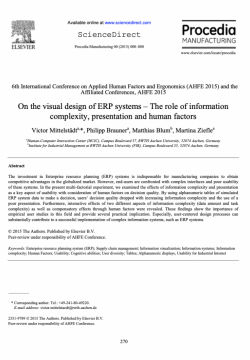
Abstract
The investment in Enterprise resource planning (ERP) systems is indispensable for manufacturing companies to obtain competitive advantages in the globalized market. However, end-users are confronted with complex interfaces and poor usability of these systems. In the present multi-factorial experiment, we examined the effects of information complexity and presentation as a key aspect of usability with consideration of human factors on decision quality. By using alphanumeric tables of simulated ERP system data to make a decision, users’ decision quality dropped with increasing information complexity and the use of a poor presentation. Furthermore, interactive effects of two different aspects of information complexity (data amount and task complexity) as well as compensatory effects through human factors were revealed. These findings show the importance of empirical user studies in this field and provide several practical implication. Especially, user-centered design processes can substantially contribute to a successful implementation of complex information systems, such as ERP systems.
Mittelstädt, V., Brauner, P., Blum, M., Ziefle, M.: On the Visual Design of ERP Systems – The Role of Information Complexity, Presentation and Human Factors. In: 6th International Conference on Applied Human Factors and Ergonomics (AHFE 2015) and the Affiliated Conferences, AHFE 2015. pp. 270–277 (2015).
Related Project(s):

![Fig. 3. Interaction between task complexity and data amount for the reaction times in [s] (a). Main effect of classification (presentation and perceptual speed; PS) for the reaction times in [s] (b).](/sites/default/files/styles/medium/public/2020-08/Bildschirmfoto%202020-08-20%20um%2015.56.37.png?itok=nQXrk7yw)